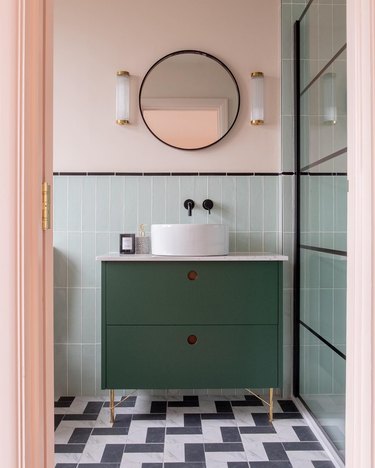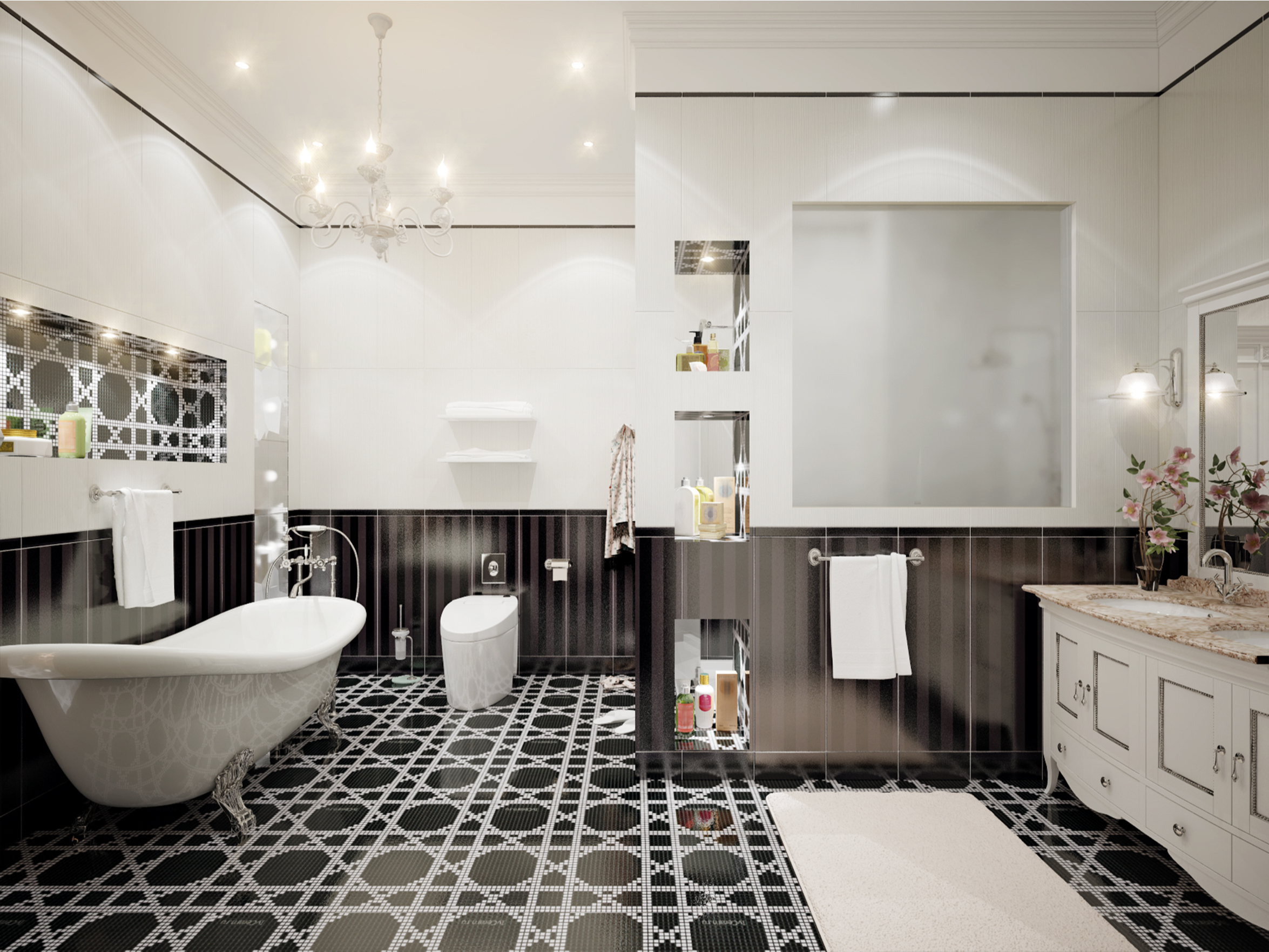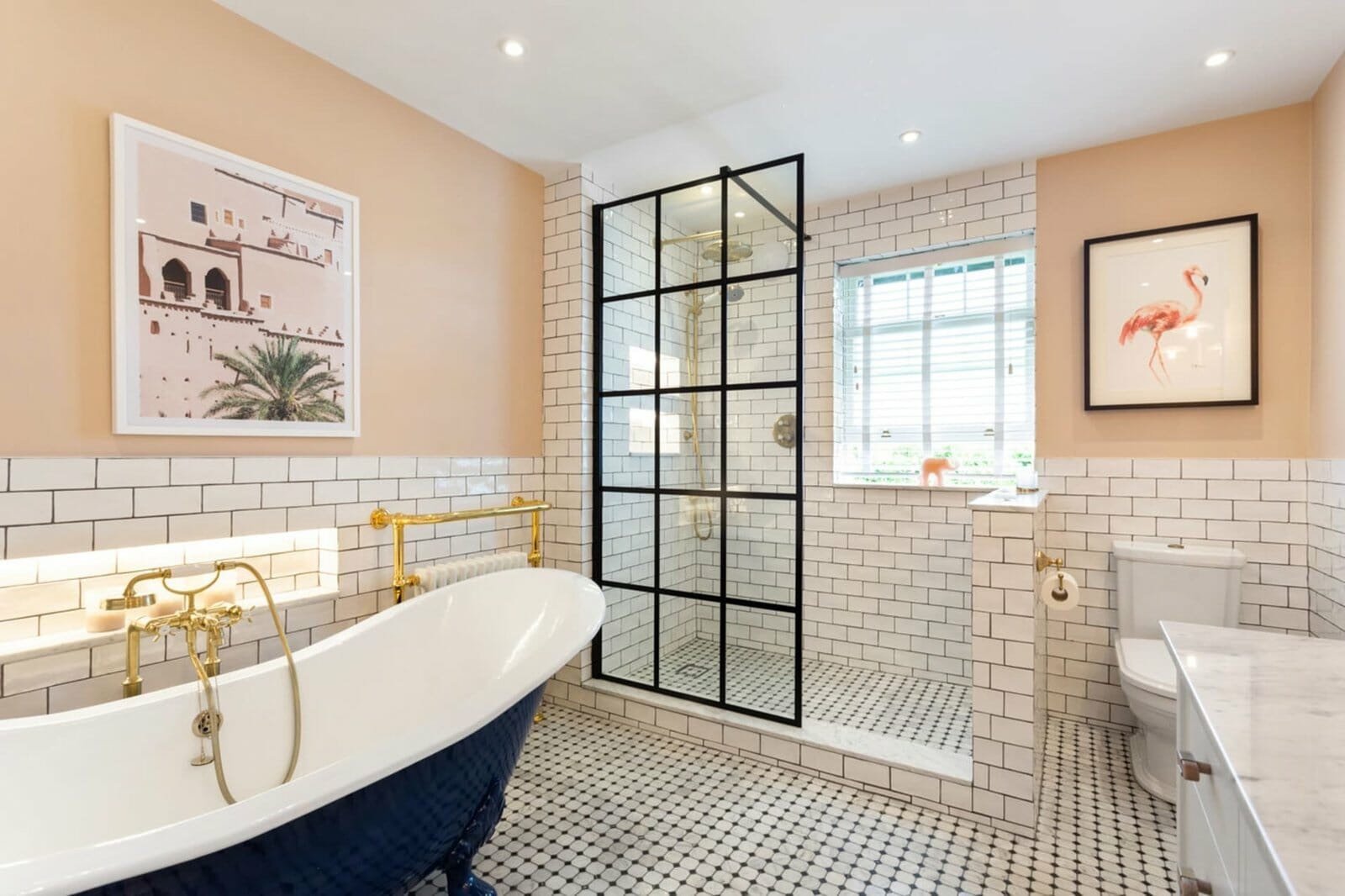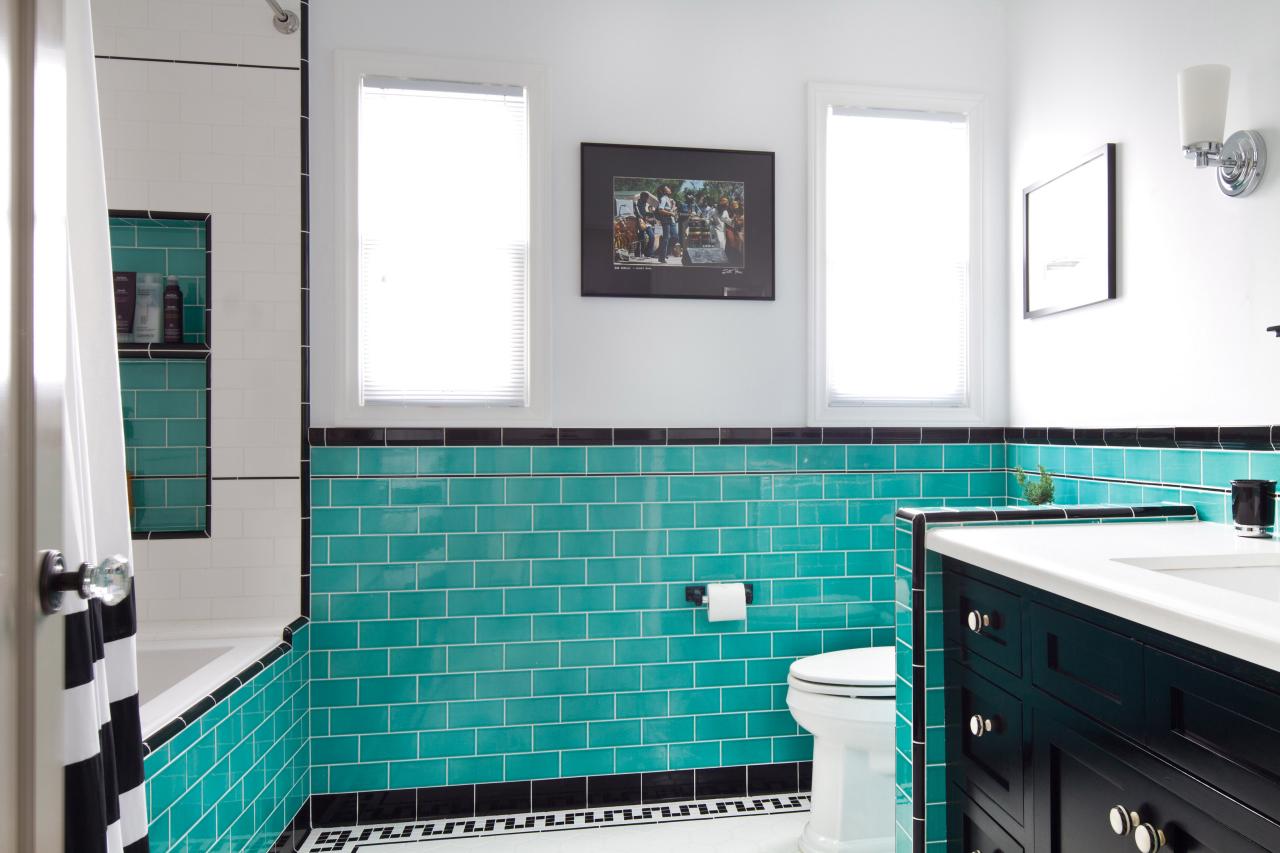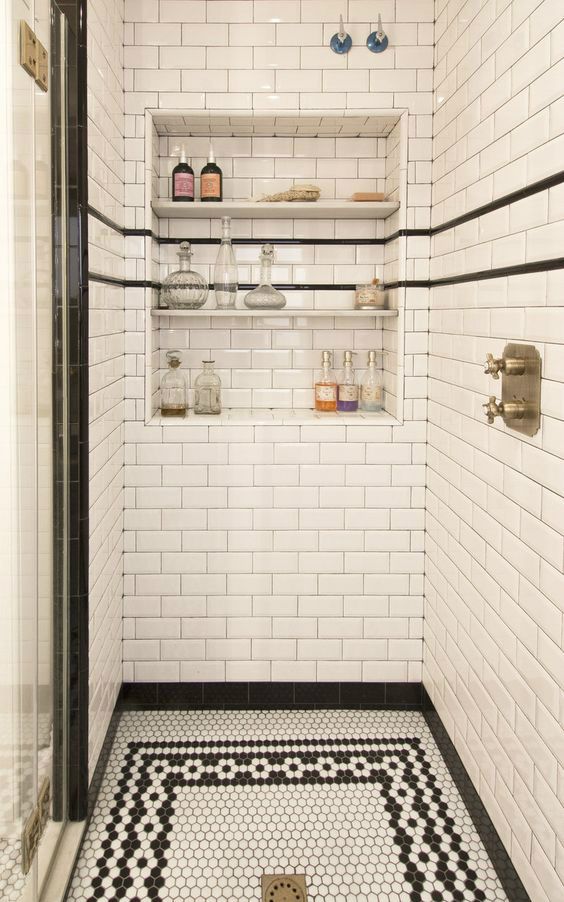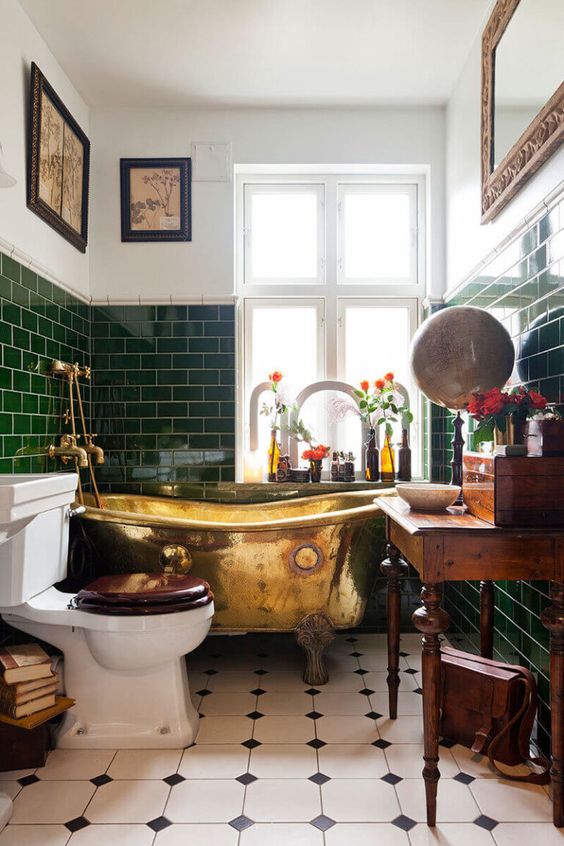The Charm of Classic Subway Tiles
Subway tiles have been a staple in bathroom design since the early 1900s. Named after the tiles used in the New York City subway stations, these tiles are known for their sleek, rectangular shape and glossy finish. Their simplicity and versatility make them a popular choice for vintage bathroom designs.
- Historical Appeal: Subway tiles were first introduced in the early 20th century and quickly became popular due to their clean, simple lines and easy-to-clean surfaces. They were originally used in subway stations for their durability and practicality but soon found their way into homes. The classic 3×6 inch white tiles became a symbol of the Art Deco and Art Nouveau movements, making them an iconic choice for vintage bathroom designs.
- Versatile Design Options: One of the main appeals of subway tiles is their versatility. While the classic white subway tile is timeless, these tiles now come in a variety of colors, sizes, and finishes. From glossy to matte, beveled to flat, the options are endless. This allows homeowners to customize their vintage bathroom while maintaining the charm and simplicity of the original design.
- Timeless Elegance: Subway tiles bring a timeless elegance to any bathroom. Their clean lines and simple design create a serene and uncluttered look. This timeless appeal means that they won’t go out of style, making them a great investment for any home. Whether you’re going for a completely vintage look or mixing old and new, subway tiles can seamlessly fit into any design scheme.
- Ease of Installation: Another advantage of subway tiles is their ease of installation. Their uniform shape and size make them easy to lay in a variety of patterns. The classic brick pattern is the most popular, but subway tiles can also be laid in herringbone, vertical, or stack bond patterns for a unique twist. This flexibility in design means you can create a custom look that suits your style.
- Durability and Maintenance: Subway tiles are not only stylish but also practical. Made from ceramic or porcelain, they are highly durable and resistant to moisture, making them perfect for bathrooms. Their smooth, glossy surface makes them easy to clean, requiring only a wipe-down with a damp cloth. This low maintenance quality makes them a favorite among busy homeowners.
- Enhancing Small Spaces: Subway tiles are particularly effective in small bathrooms. Their reflective surface and light color can make a small space appear larger and brighter. By using a light-colored grout, you can create a seamless look that further enhances the sense of space. This makes subway tiles an ideal choice for bathrooms of all sizes.

Timeless Beauty of Hexagonal Tiles
Hexagonal tiles, often referred to as hex tiles, have a long history in bathroom design. Their unique shape and vintage appeal make them a popular choice for those looking to add a touch of nostalgia to their bathroom.
Historical Significance: Hexagonal tiles date back to the early 1900s and were commonly used in Victorian and early 20th-century homes. Their distinctive six-sided shape and small size made them a popular choice for intricate floor patterns. The classic black and white hex tile design became synonymous with vintage bathrooms, adding a sense of history and charm.
Variety of Materials: Hexagonal tiles are available in a variety of materials, including ceramic, porcelain, and natural stone. Each material offers a different look and feel, allowing homeowners to choose the perfect tile to match their vintage bathroom design. Ceramic and porcelain tiles are popular for their durability and ease of maintenance, while natural stone tiles add a touch of luxury and uniqueness.
Design Versatility: The geometric shape of hexagonal tiles offers endless design possibilities. They can be arranged in simple monochromatic patterns or intricate multi-colored designs. Popular patterns include flower motifs, checkerboards, and honeycomb designs. The versatility of hex tiles allows for a high level of customization, making it easy to create a unique and personalized bathroom space.
Color and Finish Options: Hexagonal tiles come in a wide range of colors and finishes, from classic black and white to bold, vibrant hues. Matte and glossy finishes offer different visual effects, with matte providing a more subdued, vintage look and glossy adding a modern twist. By mixing and matching colors and finishes, homeowners can create a dynamic and visually interesting bathroom design.
Creating Focal Points: Hexagonal tiles can be used to create stunning focal points in a bathroom. For example, a patterned hex tile floor can draw attention to the center of the room, while a hex tile backsplash can highlight a vanity or sink area. By strategically placing hex tiles, you can enhance the overall design and create a visually appealing space.
Durability and Maintenance: Like subway tiles, hexagonal tiles are known for their durability and ease of maintenance. Porcelain and ceramic hex tiles are highly resistant to moisture and wear, making them ideal for bathroom floors and walls. Their smooth surface makes cleaning a breeze, ensuring that your vintage bathroom remains beautiful and functional for years to come.
Patterned Tiles: Adding a Touch of Nostalgia
Patterned tiles are a great way to add a touch of nostalgia and personality to a vintage bathroom. With a wide variety of designs available, they offer endless possibilities for creating a unique and stylish space.
Historical Patterns: Patterned tiles have been used for centuries to add decorative elements to homes. From intricate Victorian designs to bold Art Deco patterns, these tiles can bring a sense of history and elegance to your bathroom. By choosing historical patterns, you can create a bathroom that feels both timeless and nostalgic.
Mixing Patterns and Colors: One of the benefits of patterned tiles is the ability to mix and match different designs and colors. This allows you to create a truly unique bathroom that reflects your style. For example, you can combine floral motifs with geometric patterns or mix bold colors with neutral tones. The key is to find a balance that creates a cohesive and visually appealing look.
Accent Walls and Floors: Patterned tiles can be used to create stunning accent walls and floors in a bathroom. A patterned tile wall behind a vanity or bathtub can serve as a focal point, adding depth and interest to the space. Similarly, a patterned tile floor can create a sense of movement and energy, making the bathroom feel more dynamic and lively.
Vintage-Inspired Designs: Many tile manufacturers offer vintage-inspired patterned tiles that replicate the look of traditional designs. These tiles often feature intricate details and classic color palettes, making them perfect for a vintage bathroom. By choosing vintage-inspired tiles, you can achieve an authentic look without sacrificing modern quality and durability.
Combining with Plain Tiles: To prevent a patterned tile design from becoming overwhelming, it’s a good idea to combine patterned tiles with plain ones. This creates a balanced look that is both visually interesting and harmonious. For example, you can use patterned tiles on the floor and plain tiles on the walls, or vice versa. This approach allows the patterned tiles to stand out without dominating the space.
Creating a Cohesive Look: When using patterned tiles, it’s important to consider the overall design of the bathroom. Choose patterns and colors that complement the existing fixtures and decor. By coordinating the tiles with the rest of the bathroom, you can create a cohesive and well-designed space that feels both stylish and nostalgic.
Art Deco Inspirations in Tile Designs
Art Deco is a design style that emerged in the 1920s and 1930s, characterized by bold geometric shapes, vibrant colors, and luxurious materials. Incorporating Art Deco tile designs into a vintage bathroom can add a touch of glamour and sophistication.
Geometric Patterns: Art Deco is known for its use of geometric patterns, and this can be seen in many tile designs from the era. Zigzags, chevrons, and diamond shapes are all popular motifs that can be incorporated into a bathroom design. These patterns add visual interest and a sense of movement, making the bathroom feel dynamic and stylish.
Bold Colors: Art Deco designs often feature bold and vibrant colors, such as black, gold, teal, and red. These colors can be used in tile designs to create a striking and dramatic look. For example, black and gold tiles can create a luxurious and opulent feel, while teal and red tiles can add a pop of color and energy to the space.
Luxurious Materials: In addition to bold colors and geometric patterns, Art Deco is also characterized by the use of luxurious materials. Marble, glass, and metallic tiles are all great choices for an Art Deco-inspired bathroom. These materials add a sense of richness and sophistication, making the bathroom feel more upscale and elegant.
Accent Pieces: Incorporating Art Deco-inspired accent pieces can enhance the overall design of the bathroom. For example, you can use a decorative tile border or a mosaic tile mural to create a focal point. These accent pieces can add a touch of glamour and artistry, elevating the overall look of the bathroom.
Mixing Old and New: While Art Deco is a vintage design style, it can be combined with modern elements to create a unique and eclectic look. For example, you can pair Art Deco tiles with contemporary fixtures and fittings, such as a modern vanity or sleek faucets. This blend of old and new creates a timeless and sophisticated bathroom that feels both classic and current.
Creating a Glamorous Atmosphere: The ultimate goal of an Art Deco-inspired bathroom is to create a glamorous and luxurious atmosphere. This can be achieved through the careful selection of tiles, colors, and materials. By incorporating bold geometric patterns, vibrant colors, and luxurious materials, you can create a bathroom that feels like a stylish retreat.
Retro Color Schemes: Bringing Back the Past
Color plays a crucial role in creating a vintage bathroom design. Retro color schemes can add a touch of nostalgia and personality, transforming an ordinary bathroom into a stylish and inviting space.
Pastel Hues: Pastel colors were popular in the 1950s and 1960s and are perfect for creating a vintage bathroom. Soft pinks, mint greens, baby blues, and buttery yellows can all be used to create a retro look. These colors add a sense of warmth and charm, making the bathroom feel cozy and inviting.
Bold Combinations: In addition to pastels, bold color combinations were also popular in retro design. For example, black and white tiles can create a classic and timeless look, while red and white tiles add a touch of drama and energy. These bold combinations can make a statement and add a sense of fun and playfulness to the bathroom.
Earthy Tones: Earthy tones, such as terracotta, mustard yellow, and olive green, were popular in the 1970s and can be used to create a vintage-inspired bathroom. These colors add a sense of warmth and richness, making the bathroom feel more inviting and comfortable. They can be combined with natural materials, such as wood and stone, to create a cohesive and harmonious look.
Monochromatic Schemes: Monochromatic color schemes were also popular in vintage design. For example, an all-blue bathroom can create a serene and calming atmosphere, while an all-pink bathroom adds a touch of femininity and charm. By using different shades and textures of the same color, you can create a dynamic and visually interesting bathroom.
Accent Colors: Using accent colors is a great way to add a touch of retro style to a bathroom. For example, you can use bold accent colors, such as red or teal, to highlight certain features, such as a vanity or bathtub. This adds a pop of color and creates a focal point, making the bathroom feel more dynamic and lively.
Coordinating Decor: To create a cohesive look, it’s important to coordinate the color scheme with the rest of the bathroom decor. This includes choosing towels, rugs, and accessories that complement the tile colors. By coordinating the decor, you can create a harmonious and well-designed bathroom that feels both stylish and nostalgic.
Mixing and Matching Vintage Styles
Combining different vintage styles can create a unique and eclectic bathroom that reflects your taste. By mixing and matching different elements, you can create a space that feels both stylish and nostalgic.
Combining Different Eras: One way to mix and match vintage styles is to combine elements from different eras. For example, you can pair Victorian-style fixtures with mid-century modern tiles, or Art Deco patterns with 1970s color schemes. This creates a dynamic and visually interesting bathroom that feels both timeless and eclectic.
Balancing Old and New: To prevent a mixed vintage bathroom from feeling too chaotic, it’s important to balance old and new elements. For example, you can combine vintage tiles with modern fixtures and fittings, such as a sleek vanity or contemporary faucets. This blend of old and new creates a cohesive and harmonious look that feels both classic and current.
Creating Focal Points: When mixing and matching vintage styles, it’s important to create focal points to anchor the design. For example, a patterned tile floor can serve as the centerpiece of the bathroom, while a vintage mirror or light fixture can add a touch of elegance and charm. By creating focal points, you can guide the eye and create a balanced and well-designed space.
Using Neutral Backgrounds: Using neutral backgrounds can help to balance and harmonize different vintage elements. For example, white subway tiles or neutral-colored walls can provide a backdrop for bold and colorful vintage tiles. This creates a clean and uncluttered look, allowing the vintage elements to stand out without overwhelming the space.
Incorporating Personal Touches: Adding personal touches can make a mixed vintage bathroom feel more unique and special. This can include vintage accessories, such as a retro soap dish or an antique towel rack, as well as personal items, such as framed photos or artwork. These personal touches add character and charm, making the bathroom feel more inviting and comfortable.
Experimenting with Patterns and Textures: Mixing and matching different patterns and textures can add depth and interest to a vintage bathroom. For example, you can combine patterned tiles with textured wallpaper, or mix different types of tiles, such as hexagonal and subway tiles. This creates a dynamic and visually interesting bathroom that feels both stylish and nostalgic.
Maintenance Tips for Vintage Bathroom Tiles
Maintaining vintage bathroom tiles requires a bit of care and attention to keep them looking their best. With the right cleaning and maintenance techniques, you can ensure that your vintage tiles remain beautiful and functional for years to come.
Regular Cleaning: Regular cleaning is essential to keep vintage tiles looking their best. Use a mild, non-abrasive cleaner and a soft cloth or sponge to wipe down the tiles. Avoid using harsh chemicals or abrasive scrubbers, as these can damage the tiles and grout. For tougher stains, a mixture of baking soda and water can be used as a gentle scrubbing paste.
Sealing Grout: Grout can become discolored and damaged over time, so it’s important to keep it properly sealed. Use a high-quality grout sealer to protect the grout from moisture and stains. Apply the sealer according to the manufacturer’s instructions, and reapply as needed to maintain the seal. This will help to keep the grout looking clean and fresh and prevent mold and mildew growth.
Repairing Chips and Cracks: Over time, vintage tiles may develop chips or cracks. To repair minor damage, use a matching tile repair kit, which can be found at most hardware stores. For larger repairs, it’s best to consult a professional. Keeping the tiles in good condition will help to preserve the overall look and integrity of the bathroom.
Preventing Water Damage: Water damage can be a major issue in bathrooms, especially for vintage tiles. To prevent water damage, make sure that the bathroom is properly ventilated, and use a shower curtain or door to contain water. Wipe down the tiles and grout after each use to remove excess moisture, and promptly repair any leaks or drips.
Avoiding Heavy Impact: Vintage tiles can be more fragile than modern tiles, so it’s important to avoid heavy impacts. Be careful when moving furniture or heavy objects in the bathroom, and use protective pads under furniture legs. This will help to prevent chips and cracks, and keep the tiles looking their best.
Professional Cleaning and Maintenance: For deep cleaning and maintenance, consider hiring a professional. Professional tile and grout cleaning services can remove deep stains and restore the original luster of the tiles. They can also provide expert advice on how to care for and maintain your vintage bathroom tiles.
Refined Vintage Bathroom Décor Ideas
Best Bathroom Tile Ideas – Beautiful Floor and Wall Tile
Historic Bathroom Tile Designs: ORC Week Two
Reasons to Love Retro Pink-Tiled Bathrooms
Our Favorite Sources For Mid-Century Modern Bathroom Tile
Related Posts:
